KEY TAKEAWAYS
- The study aimed to identify the correlation between BMI and outcomes in pts with melanoma post-TKI treatment.
- VATGI, a body composition-based marker, shows promising potential in predicting patient outcomes in melanoma.
Tyrosine kinase inhibitors (TKIs) have recently represented a significant advancement in the management of metastatic melanoma. A clinical correlation has been established between body mass index (BMI) and patient outcomes in metastatic melanoma. However, conflicting results have cast doubt on the relevance of this association.
Miriam Menourgoni and the team aimed to analyze and dissect various body composition features among patients with melanoma treated with TKI. The objective was to evaluate these features as potential biomarkers to better understand their predictive value in patient outcomes.
Researchers analyzed the body composition features via CT scans in a retrospective cohort of 57 pts with non-resectable stage III/IV melanoma receiving first-line (1L) treatment with TKI in the department, focusing on the impact of body composition on treatment efficacy and the occurrence of adverse events (AEs).
The results indicated that in both uni- and multivariate analyses, they discovered an association between survival and the visceral adipose tissue gauge index (VATGI). Additionally, they conducted profiling of other body composition features, such as sarcopenia, which also showed a correlation with shorter overall survival. Furthermore, they observed an increased prevalence of fatigue among pts with low VATGI.
The study concluded that body composition could serve as potential biomarkers in TKI-treated melanoma, with VATGI showing promise in predicting patient outcomes.
The study was funded by the Else Kröner-Fresenius-Stiftung and Projekt DEAL.
Source: https://pubmed.ncbi.nlm.nih.gov/38857075/
Mengoni M., Braun A.D., Hinnerichs M.S., et al. (2024) “Comprehensive analysis of body composition features in melanoma patients treated with tyrosine kinase inhibitors.” J Dtsch Dermatol Ges. 2024 Jun;22(6):783-791. doi: 10.1111/ddg.15402. PMID: 38857075.



